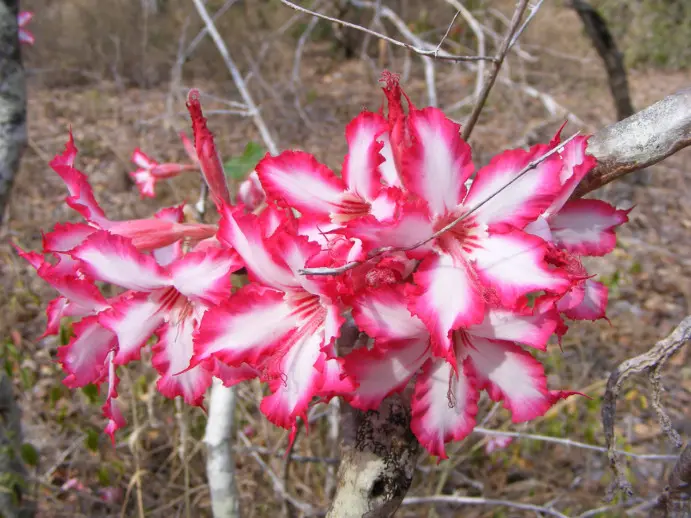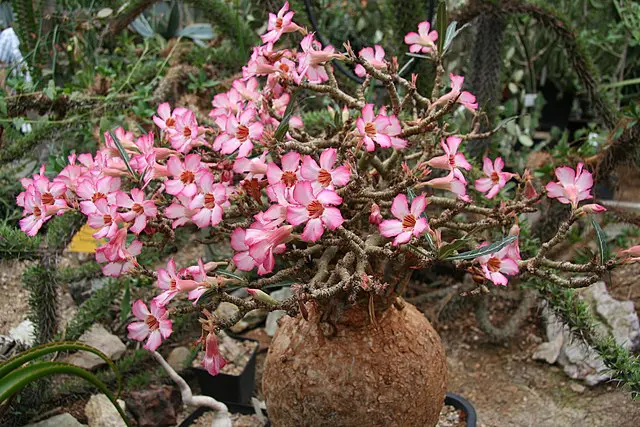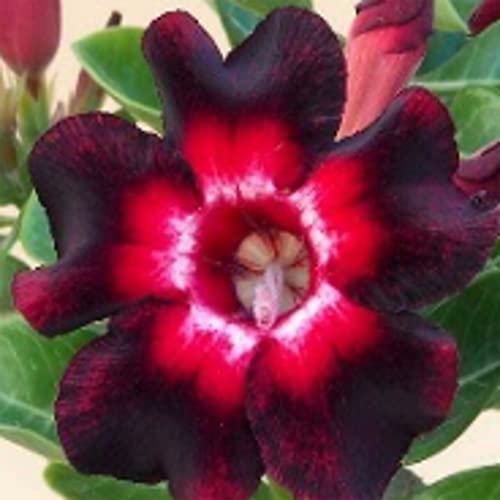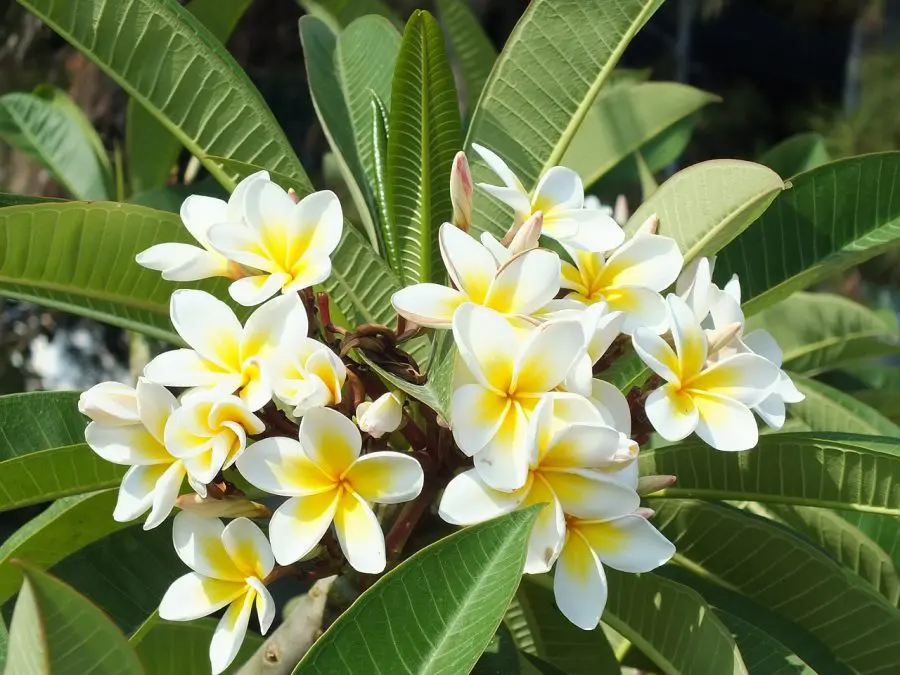This post contains affiliate links. If you buy something from one of our links we may earn a commission. Thanks
![]()
Discover the joys of Growing Adenium Desert Rose Indoors with our comprehensive guide! Learn tips, tricks, and expert advice for a thriving indoor oasis.
Growing Adenium Desert Rose indoors requires plenty of sunlight, ideally 6 hours a day, and well-draining soil. Water the plant sparingly; it prefers to be slightly dry rather than overly moist. Maintaining a temperature range of 60-90°F will help the plant thrive. Fertilize lightly during the growing season.
Are you looking to add a touch of exotic beauty to your indoor garden? Growing Adenium Desert Rose Indoors might be just what you need!
These stunning succulent plants boast vibrant blooms and sculptural forms, making them a unique addition to any indoor space.
So let’s dive in and transform your space into an enchanting desert oasis!
Introduction To Adenium Desert Rose
Growing Adenium Desert Rose Indoors
Welcome to the enchanting world of Adenium Desert Rose, a fascinating plant with vibrant blooms and eye-catching forms that make it a captivating addition to any indoor garden.
In this guide, we’ll explore various aspects of growing and caring for this delightful plant, from choosing the perfect variety to mastering its unique care requirements.
We’ll cover topics like lighting, watering, pruning, and so much more. So, sit back and get ready to embark on an exciting journey as we delve into the mesmerizing world of Adenium Desert Rose.
Getting to Know Adenium Desert Rose
Adenium Desert Rose, also known as the Desert Rose or Impala Lily, is a stunning succulent plant native to the arid regions of Africa and the Arabian Peninsula.
It’s highly admired for its vibrant, trumpet-shaped flowers that come in a wide range of colors, including shades of pink, red, and white.
With its thick, swollen stem and caudex, the Adenium Desert Rose has a sculptural quality that adds visual interest to any indoor space.
Their unique appearance and hardy nature make them a favorite among plant enthusiasts and beginners alike.
Adenium is a genus of flowering plants in the family Apocynaceae first described as a genus in 1819. It is native to Africa and the Arabian Peninsula.
Adenium obesum is grown as a houseplant in temperate and tropical regions. Numerous hybrids have been developed. Adeniums are appreciated for their colorful flowers, but also for their unusual, thick caudices. They can be grown for many years in a pot and are commonly used for bonsai. https://en.wikipedia.org/wiki/Adenium
The Perks of Growing Desert Rose Indoors
While the Adenium Desert Rose thrives in its natural habitat, it can also be successfully grown indoors, giving you the opportunity to enjoy its stunning beauty year-round.
Growing Desert Rose indoors comes with several benefits, such as protecting the plant from harsh outdoor elements like frost and extreme heat.
Additionally, indoor cultivation offers you more control over the plant’s growing conditions, such as temperature, humidity, and light, ensuring that your Desert Rose flourishes.
Furthermore, having a Desert Rose in your home can create a unique focal point and bring a touch of exotic charm to your living space.
Can You Keep Desert Rose Indoors?
You might be wondering, “Can I really keep a Desert Rose indoors?” The answer is a resounding yes!
These captivating plants can absolutely thrive in your home, bringing their exotic charm and vibrant blooms to brighten up your living space.
In the following sections, we’ll explore the ins and outs of growing and caring for a Desert Rose indoors.
We’ll discuss the ideal conditions and requirements, ensuring that your plant not only survives but flourishes within the cozy confines of your home.
So, let’s dive in and learn how to make your indoor Desert Rose feel right at home!
Benefits of Growing Desert Rose Indoors
Growing a Desert Rose indoors comes with several advantages that can make the whole experience more enjoyable and rewarding.
First and foremost, by cultivating your Desert Rose inside, you can protect it from the harsh outdoor elements, such as frost, extreme heat, and strong winds.
This is especially important if you live in a region with a climate that doesn’t suit the plant’s natural preferences.
Another advantage of growing Desert Rose indoors is the ability to control and maintain the ideal growing conditions.
This ensures that your plant remains healthy and vibrant throughout the year. Plus, having a Desert Rose indoors allows you to enjoy its stunning beauty up close, making it a fantastic conversation starter when guests visit your home.
Essential Indoor Growing Conditions
To successfully grow a Desert Rose indoors, it’s crucial to provide the necessary conditions for its optimal growth. Here are some key factors to consider:
• Light: Desert Roses need plenty of bright, indirect sunlight to thrive. A south or west-facing window is usually the best spot to place your plant.
If natural light is insufficient, you can supplement it with artificial grow lights.
• Temperature: These plants prefer warm temperatures between 65-85°F (18-29°C) during the day and slightly cooler at night.
Avoid placing your Desert Rose near drafty windows or heating vents, as extreme temperature fluctuations can harm the plant.
• Humidity: Desert Roses can tolerate low humidity levels, but it’s essential to maintain a balance.
Placing a tray filled with water and pebbles under your plant can help increase humidity without causing waterlogged soil.
• Soil: Well-drained potting mix is crucial for a healthy Desert Rose. Use a mix that contains equal parts potting soil, perlite or pumice, and sand to ensure proper drainage and prevent root rot.
Or you can use coco coir and perlite for well-drained soil. Potting mixes contain peat moss whose harvest destroys peat bogs and release large amounts of co2.
Coco coir is a sustainable environmentally friendly alternative and actually works better than sphagnum peat.
• Pot: Choose a pot with drainage holes to allow excess water to escape. A slightly larger pot can encourage your Desert Rose to grow larger, but be cautious not to choose one that’s too big, as it may lead to overwatering.
Desert Rose Varieties
Ready to explore the dazzling world of Desert Rose varieties? With their captivating blooms and intriguing forms, it’s no wonder that Adenium plants have captured the hearts of plant lovers worldwide.
In this section, we’ll introduce you to some of the most popular and eye-catching varieties, each with its unique charm and characteristics.
Whether you’re a seasoned collector or just starting your journey into the realm of indoor gardening, discovering these stunning Desert Rose varieties is sure to ignite your passion for these mesmerizing plants.
So, let’s dive in and uncover the captivating beauties that await!
Popular Adenium Desert Rose Varieties
There’s a whole world of Adenium Desert Rose varieties out there, each with its distinct features and allure.
Here are some of the most common and beloved types you might come across:
Adenium obesum: Often considered the “classic” Desert Rose, this variety is known for its thick caudex and large, showy flowers that come in shades of pink, red, white, and even yellow.
Adenium multiflorum: Also called the “Impala Lily,” this variety boasts smaller, more numerous flowers in striking white, pink, and occasionally yellow hues. Its branches are more slender compared to Adenium obesum, giving it a delicate appearance.

Adenium arabicum: This variety stands out for its strikingly large and swollen caudex, which serves as a water reservoir during dry spells. Its flowers are typically smaller and come in shades of pink, red, and sometimes yellow.

Adenium somalense: With a tall, slender trunk and smaller blooms in shades of pink, white, and even yellow, this variety has a unique, elegant look that sets it apart from other Desert Roses.

Distinguishing Features of Different Varieties
As you explore the various Adenium Desert Rose varieties, you’ll notice that each one has unique characteristics that make it special. Here are some key features to look out for:
Flower size and color: Different varieties showcase a wide range of flower sizes and colors, from bold reds, pinks, and sunny yellows to more subtle white and cream hues. Some even exhibit multi-colored or striped petals, adding an extra touch of allure.
Caudex shape and size: The caudex, or swollen stem base, can vary significantly between varieties. Some may have a more prominent and rounded caudex, while others might have a slender, elongated appearance.
Growth habit: Desert Roses can have diverse growth habits, ranging from compact and bushy to tall and slender. This can impact the overall look and feel of your plant, as well as its suitability for specific indoor spaces.
As you delve into the world of Desert Rose varieties, you’ll likely find the perfect one (or several!) to suit your taste and indoor gardening needs, with captivating colors including cheerful yellows to brighten up your home.
Desert Rose Lifespan
Curious about how long your enchanting Desert Rose will grace your indoor space with its captivating presence?
In this section, we’ll explore the lifespan of these beautiful plants and the factors that contribute to their longevity.
By understanding the ins and outs of Desert Rose care, you’ll be better equipped to ensure your plant thrives for years to come.
So, let’s uncover the secrets to a long and happy life for your Adenium Desert Rose, and keep the magic alive in your indoor garden for as long as possible!
Average Lifespan of a Desert Rose Plant
The longevity of a Desert Rose can vary depending on several factors, but on average, these plants can live for 10-20 years or even longer when given the proper care.
Some particularly well-cared-for specimens have been known to live for several decades, making them a long-lasting addition to your indoor garden.
Factors That Impact Desert Rose Lifespan
Several factors can influence the overall lifespan of your Desert Rose. By understanding these variables, you can create the ideal environment to ensure your plant thrives for years to come:
• Care and maintenance: Providing your Desert Rose with the appropriate care – including proper watering, fertilization, and pruning – is essential for its long-term health and well-being.
• Light: Desert Roses need plenty of bright full sun to thrive: Ensuring your plant gets adequate light will help promote strong growth and a longer lifespan.
• Temperature and humidity: Maintaining the right temperature and humidity levels is crucial for the health of your Desert Rose. Extreme fluctuations or unsuitable conditions can stress the plant and potentially shorten its lifespan.
• Soil and drainage: Using well-draining soil and a pot with proper drainage is essential to prevent root rot and other issues that can negatively impact your plant’s longevity.
• Pest and disease management: Keeping an eye out for pests and diseases and addressing them promptly is vital to ensure your Desert Rose remains healthy and lives a long life.
A terra-cotta pot will wick away excess moisture and may need more frequent watering while plastic or ceramic pots will generally need less watering.
By paying attention to these factors and providing your Desert Rose with the care it needs, you can increase the chances of it gracing your home with its beauty for many years to come.
Adenium Desert Rose Lighting
Looking to illuminate your Adenium Desert Rose’s world in the best way possible?
Lighting plays a crucial role in the overall health and well-being of your Desert Rose, so it’s essential to understand the plant’s lighting needs.
In this section, we’ll delve into the ideal lighting conditions for your Adenium, ensuring that it grows strong, vibrant, and beautifully blooming.
So, let’s shed some light on this topic and help your Desert Rose truly shine in your indoor garden!
Light Requirements for Desert Rose Growth
Adenium Desert Roses are sun-loving plants that require ample light to grow and bloom to their fullest potential.
Here’s what you need to know about their light preferences:
Intensity: Desert Roses thrive with plenty of direct sunlight, but they also appreciate some periods of indirect light. Find a sunny spot for it and aim to provide at least 4-6 hours of direct sunlight per day to ensure healthy growth and abundant blooms.
Duration: In addition to the direct sunlight, your Desert Rose will benefit from bright, indirect light for the remainder of the day.
Seasonal changes: As the seasons change, so do the lighting conditions in your home. Keep an eye on the shifting patterns of sunlight and adjust your plant’s location accordingly to ensure it receives consistent light throughout the year.
Tips for Providing Optimal Indoor Lighting
To create the ideal lighting conditions for your Desert Rose indoors, consider these helpful tips:
• Choose the right spot: Place your Desert Rose near a south or west-facing window, where it can receive ample direct sunlight each day.
• Monitor sun exposure: Keep an eye on your plant’s foliage to ensure it’s not getting sunburned.
If you notice any scorching, consider moving the plant slightly away from the window or filtering the light with a sheer curtain.
• Use supplemental lighting: If your indoor space doesn’t provide enough natural sunlight, consider using artificial grow lights to supplement the light your Desert Rose receives.
This can help ensure it gets the 4-6 hours of direct light it needs for healthy growth and flowering.
By providing the right lighting conditions for your Desert Rose, you’ll be well on your way to enjoying a thriving and vibrant plant in your indoor garden.
What Type of Soil is Best for Desert Rose?
Ready to give your Adenium Desert Rose the perfect foundation for thriving indoors? Choosing the right soil mix is essential for your plant’s health, and in this section, we’ll discuss the ideal soil blend for your Desert Rose.
We’ll also recommend a coco coir and perlite mix over peat-based potting mixes, as it offers excellent drainage and aeration to keep your plant happy and healthy.
So, let’s get down to the nitty-gritty and learn how to create the perfect environment for your Desert Rose’s roots to flourish and support its stunning blooms!
Soil Composition and Drainage Requirements
The right soil mix for your Desert Rose is crucial for its health and well-being. Here are the key factors to consider when choosing the perfect blend:
Drainage: Desert Roses require well-draining soil to prevent root rot and other moisture-related issues. A mix that allows water to flow freely is essential for keeping your plant’s roots healthy.
Aeration: The soil should provide ample aeration to allow the roots to breathe, which is important for their overall health.
Nutrient content: A mix that provides a balanced supply of nutrients will ensure your Desert Rose has the necessary support for strong growth and beautiful blooms.
Preparing Soil Mix for Desert Rose
To create the ideal soil blend for your Adenium Desert Rose, consider these steps:
Choose the right ingredients: Opt for a mix of coco coir and perlite, which provides excellent drainage, aeration, and nutrient balance.
Coco coir by itself is a growing medium but does not supply nutrients, so it’s essential to mix in a slow-release fertilizer.
This combination is preferred over peat-based potting mixes, as it is more sustainable and offers better results for your plant.
Mix it up: Combine equal parts of coco coir and perlite, ensuring that they are thoroughly mixed to create a uniform blend.
Add nutrients: Incorporate a slow-release fertilizer into the soil mix to provide the necessary nutrients for your plant’s growth and flowering.
This addition will help compensate for the lack of nutrients in coco coir and create a well-rounded growing medium.
Test drainage: Before planting your Desert Rose, test the drainage of your soil mix by watering it in a container. The water should flow through the mix easily and not pool at the bottom.
By creating the perfect soil mix for your Adenium Desert Rose, you’ll give your plant the foundation it needs for healthy growth, vibrant blooms, and long-lasting beauty.
Repotting Desert Rose
Is it time to give your Adenium Desert Rose a fresh start and a new home?
Repotting your plant is an essential part of its care routine, ensuring it has enough space to grow and flourish.
In this section, we’ll guide you through the process of repotting your Desert Rose, sharing tips and tricks for a smooth transition that benefits your plant’s health and well-being.
Let’s dive in and learn how to give your Desert Rose the room it needs to continue captivating you with its stunning blooms and unique appearance!
When and Why to Repot Your Desert Rose
Knowing when and why to repot your Desert Rose is crucial for its long-term health and happiness. Here’s what you need to know:
Timing: Repotting is best done in early spring, just before the growing season begins. This timing ensures your plant has the energy and resources to adjust to its new home.
Root growth: If you notice roots emerging from the drainage holes or circling the surface of the soil, it’s a sign that your Desert Rose is outgrowing its current pot and needs more room to grow.
Soil depletion: Over time, the nutrients in the soil become depleted, and repotting offers an opportunity to refresh the growing medium and provide your plant with the necessary nutrients.
Step-by-Step Repotting Guide
Follow these steps for a successful repotting experience:
• Choose a new pot: Select a pot that is 1-2 inches larger in diameter than the current one, with proper drainage holes to ensure adequate water flow.
• Prepare the new soil mix: Combine equal parts coco coir and perlite, and mix in a slow-release fertilizer to create a nutrient-rich, well-draining soil blend.
• Remove the plant: Carefully remove your Desert Rose from its current pot, gently loosening the roots and shaking off excess soil.
• Inspect the roots: Examine the root system for any signs of rot or damage, and trim away any unhealthy roots with clean, sharp scissors.
• Place in the new pot: Position your Desert Rose in the center of the new pot, and fill it with the prepared soil mix, ensuring the roots are fully covered and the plant is well-supported.
• Water thoroughly: Water your newly repotted Desert Rose until water flows from the drainage holes, helping the soil settle and ensuring the roots have proper hydration.
• Monitor and care: Keep an eye on your plant over the next few weeks, providing the necessary care and monitoring for any signs of stress or adjustment issues.
By following this repotting guide, you’ll ensure your Desert Rose has the space and nutrients it needs to grow and thrive in its new home.
Desert Rose Watering
Wondering how to quench your Adenium Desert Rose’s thirst without overdoing it?
Proper watering is key to maintaining a healthy and happy plant, and in this section, we’ll discuss the ins and outs of Desert Rose watering.
We’ll share tips on how to strike the perfect balance between providing enough moisture for growth and preventing overwatering that can lead to root rot.
So let’s get ready to hydrate your Desert Rose in the best possible way, ensuring it continues to grace your indoor garden with its stunning blooms and captivating beauty!
Proper Watering Techniques for Desert Rose
Giving your Desert Rose the right amount of water is crucial for its well-being. Follow these guidelines for proper watering techniques:
Water deeply: When watering, ensure that the water reaches the deeper parts of the root system by watering until it flows out of the drainage holes.
Allow soil to dry: Wait for the top 1-2 inches of soil to dry out before watering again. This drying period allows the roots to breathe and prevents overwatering.
Adjust frequency: The watering frequency depends on factors like temperature, humidity, and sunlight. In general, during the growing season, you may need to water once a week, whereas, in the winter, it could be every 2-3 weeks.
Use room temperature water: Avoid using cold or hot water, as it can shock your plant. Instead, use water that is at room temperature to ensure the roots aren’t stressed.
Signs of Overwatering or Underwatering
Keeping an eye out for the signs of overwatering or underwatering can help you adjust your watering routine to better suit your Desert Rose’s needs:
Overwatering: Signs of overwatering include yellowing leaves, soft or mushy stems, and root rot. If you notice these symptoms, reduce the frequency of watering and ensure the soil is well-draining.
Underwatering: If your Desert Rose is receiving too little water, you may notice wrinkled or wilting leaves, slow growth, and a lack of blooms. To remedy this, increase the frequency of watering and ensure the plant is receiving water deep enough to reach its root system.
By following these guidelines for proper watering techniques and monitoring your Desert Rose for signs of overwatering or underwatering, you’ll be well-equipped to provide the optimal hydration needed for a healthy and vibrant plant.
Desert Rose Fertilizer
Ready to give your Adenium Desert Rose the nutrients it needs to truly shine? Providing the right fertilizer is essential for supporting your plant’s growth, vibrant blooms, and overall health.
In this section, we’ll explore the world of fertilizing your Desert Rose, discussing the best types of fertilizers to use and the ideal application schedule.
Let’s give your plant the boost it needs to flourish and captivate you with its stunning appearance in your indoor garden!
Types of Fertilizers Suitable for Desert Rose
Choosing the right fertilizer for your Adenium Desert Rose will ensure it has the necessary nutrients to thrive. Here are some types of fertilizers that work well for this plant:
Balanced fertilizer: A balanced fertilizer with equal amounts of nitrogen, phosphorus, and potassium (N-P-K) is a great choice for providing your Desert Rose with essential nutrients.
Low-nitrogen fertilizer: During the blooming season, consider using a fertilizer with a lower nitrogen content to promote more flower production.
Slow-release fertilizer: Slow-release granular fertilizers provide a steady supply of nutrients over time, ensuring your plant receives the nourishment it needs without the risk of over-fertilization.
Liquid fertilizer: For a quicker nutrient boost, liquid fertilizers can be diluted and applied directly to the soil or as a foliar spray.
Fertilizing Schedule and Application
To provide your Desert Rose with the nutrients it needs, follow these guidelines for fertilizing:
Growing season: Fertilize your Desert Rose every 4-6 weeks during the growing season, which typically spans from spring to early fall. This frequency will support growth and blooming.
Dormant period: In the winter months, when your Desert Rose enters a period of dormancy, reduce fertilization to once every 2-3 months or pause it altogether.
Application method: Always follow the manufacturer’s instructions for the specific fertilizer you’re using. This will ensure the proper dilution and application rate to avoid over-fertilizing your plant.
By understanding the types of fertilizers suitable for your Desert Rose and maintaining an appropriate fertilizing schedule, you’ll provide your plant with the nutrients it needs to grow strong, healthy, and full of stunning blooms.
Desert Rose Temperature Tolerance
Curious about how your Adenium Desert Rose will fare in different temperatures?
Desert Roses are known for their resilience, but they do have some temperature preferences to keep them happy and healthy.
In this section, we’ll discuss the temperature tolerance of your Desert Rose, sharing tips on how to maintain optimal conditions for your plant’s well-being.
Let’s explore how to ensure your Desert Rose stays cozy and comfortable, so it continues to mesmerize you with its gorgeous blooms and a striking appearance!
Ideal Temperature Range for Desert Rose Growth
To keep your Adenium Desert Rose thriving, it’s essential to understand its temperature preferences. Here are the ideal temperature ranges for your plant’s growth:
Daytime temperatures: Desert Roses prefer daytime temperatures between 70-90°F (21-32°C). This warmth promotes healthy growth and blooming.
Nighttime temperatures: At night, the temperature can drop to around 60-65°F (15-18°C) without causing any harm to your plant.
Temperature extremes: Desert Roses can tolerate brief periods of temperatures as low as 50°F (10°C), but prolonged exposure to cold temperatures can lead to leaf drop, slowed growth, and even death.
How to Maintain a Suitable Indoor Temperature
To create the best environment for your Desert Rose, follow these tips for maintaining a suitable indoor temperature:
Monitor temperature: Use a thermometer to keep track of the temperature in the area where your plant is located. This will help you make any necessary adjustments to keep the temperature within the ideal range.
Avoid drafts: Position your plant away from drafty areas, such as near air conditioning vents, open windows, or exterior doors, as drafts can cause temperature fluctuations that may stress your plant.
Use a space heater or cooler: If your indoor temperature consistently falls outside the ideal range, consider using a space heater or cooler to maintain a consistent and suitable temperature for your Desert Rose.
By understanding the ideal temperature range for Desert Rose growth and taking steps to maintain a suitable indoor temperature, you’ll provide your plant with the perfect environment to thrive and showcase its stunning beauty.
How to Prune Desert Rose
Looking for ways to keep your Adenium Desert Rose looking its best? Pruning is an essential part of maintaining your plant’s health and appearance.
In this section, we’ll dive into the art of pruning your Desert Rose, discussing the right techniques and timing to ensure your plant remains healthy, vibrant, and full of captivating blooms.
Let’s explore how to shape and care for your Desert Rose so it can continue to delight you with its striking charm and beauty!
When and Why to Prune Your Desert Rose
Understanding when and why to prune your Adenium Desert Rose is key to keeping it healthy and looking its best. Here are some reasons and ideal times for pruning:
Encourage branching: Pruning encourages branching and helps to maintain a balanced and appealing shape for your Desert Rose.
Remove dead or damaged growth: Pruning dead or damaged branches prevents the spread of diseases and pests, and allows your plant to focus its energy on healthy growth.
Timing: The best time to prune your Desert Rose is in the late winter or early spring, just before the growing season begins. This allows your plant to recover quickly and produce new growth.
Pruning Techniques for a Healthy Plant
Follow these pruning techniques to ensure a healthy and attractive Desert Rose:
Use sharp, clean tools: Clean, sharp pruning shears or a knife will create clean cuts and reduce the risk of infection.
Cut at an angle: Make your cuts at a 45-degree angle, about 1/4 inch (0.6 cm) above a leaf node or branch junction. This encourages new growth in the right direction and helps the plant heal more quickly.
Remove unwanted growth: Trim off any weak, crossing, or leggy branches to maintain a balanced and visually appealing shape.
Don’t over-prune: Be cautious not to remove too much growth at once, as it can stress your plant. Aim to remove no more than 1/3 of the plant’s total growth during a single pruning session.
By knowing when and why to prune your Desert Rose and using the proper techniques, you’ll help your plant maintain its stunning appearance and enjoy a long, healthy life.
Desert Rose Propagation 
Are you captivated by the beauty of your Adenium Desert Rose and eager to share it with friends and family or simply expand your own collection?
Propagation is the perfect way to grow new Desert Rose plants from your existing ones.
In this section, we’ll discuss two common methods of Desert Rose propagation – seeds and stem cuttings – and provide step-by-step guidance to help you achieve success in your propagation endeavors.
Get ready to multiply the charm of your indoor garden with more stunning Adenium plants!
Seed Propagation
Collecting seeds: Wait for the seed pods on your Desert Rose to mature and split open. Carefully collect the seeds, which are attached to feathery tufts, and separate them from the tufts.
Sowing seeds: Fill a seed tray or small pots with a well-draining soil mix, like a combination of coco coir, perlite, and a slow-release fertilizer. Place the seeds on the soil surface and gently press them down without completely burying them.
Watering and germination: Water the seeds lightly, and maintain consistent moisture levels while they germinate. Cover the tray or pots with a clear plastic lid or bag to create a humid environment. Keep the seeds in a warm, bright location but out of direct sunlight.
Transplanting seedlings: Once the seedlings have developed two true leaves, transplant them into individual pots with the same well-draining soil mix. Continue to care for them as you would a mature Desert Rose plant.
Stem Cutting Propagation
The best time to propagate your Desert Rose is in the late spring and summer months when it is actively growing.
Taking cuttings: Choose healthy disease-free branches from your Desert Rose and take branch cuttings from it making a clean cut using a sharp, sterilized knife or pruning shears. The cutting should be about 4-6 inches (10-15 cm) long with at least one leaf node.
Preparing the cutting: Remove any leaves from the lower part of the cutting and allow the cut end to air dry for 24-48 hours to form a callus.
Rooting the cutting: Dip the callused end of the cutting in rooting hormone and insert it about 1-2 inches (2.5-5 cm) deep into a small pot filled with a well-draining soil mix, like the coco coir, perlite, and slow-release fertilizer combination.
Encouraging root development: Place the pot in a warm, bright location but out of direct sunlight. Keep the soil slightly moist, but avoid overwatering. In about 4-6 weeks, the cutting should develop roots and begin to grow.
Caring for the new plant: Once the cutting has established a healthy root system, care for it as you would a mature Desert Rose plant.
With these propagation techniques, you’ll be able to share the stunning beauty of your Adenium Desert Rose with others and expand your own enchanting indoor garden.
Enjoy the process and watch your new plants grow and flourish under your attentive care!
Adenium Desert Rose Pests and Diseases and Treatments
Despite their hardiness, Adenium Desert Roses can sometimes fall victim to pests and diseases. But don’t worry, we’ve got your back!
In this section, we’ll discuss the common pests and diseases that can affect your Desert Rose and provide effective treatment options to keep your plant healthy and vibrant.
Let’s dive in and learn how to protect your Desert Rose from unwanted invaders and keep it flourishing with enchanting blooms and a captivating presence!
Common Pests and Diseases Affecting Desert Rose
Even the hardy Adenium Desert Rose can be affected by pests and diseases. Here are some common issues to watch for:
Pests: The most common pests that bother Desert Roses are mealybugs, spider mites, and aphids. These tiny insects can cause damage by feeding on your plant’s sap, leading to yellowing leaves, wilting, and stunted growth.
Diseases: Root rot and stem rot are two common fungal diseases that can affect Desert Roses, usually caused by overwatering or poor drainage. These diseases can lead to yellowing leaves, mushy stems, and, in severe cases, plant death.
Preventative Measures and Treatment Options
To keep your Desert Rose healthy and pest-free, follow these preventative measures and treatment options:
Maintain proper watering and drainage: Overwatering can lead to root and stem rot. Be sure to use well-draining soil, and allow the soil to dry out between waterings.
Inspect your plant regularly: Regularly check your Desert Rose for signs of pests or diseases. Early detection is key to successful treatment.
Treat pests with insecticidal soap or neem oil: If you discover pests on your Desert Rose, treat them with insecticidal soap or neem oil, following the product’s instructions. You can also remove small infestations of pests by hand or with a cotton swab dipped in rubbing alcohol.
Trim and dispose of infected parts: If your plant is affected by a fungal disease, remove the infected parts with clean, sharp pruning tools, and dispose of them in the trash. Be sure to sanitize your tools afterward to prevent spreading the disease.
Improve air circulation: Adequate air circulation around your Desert Rose can help prevent fungal diseases. Avoid overcrowding your plants and ensure they have plenty of space to breathe.
By staying vigilant and employing these preventative measures and treatments, you can keep your Adenium Desert Rose healthy and free from pests and diseases, allowing it to thrive and showcase its stunning beauty.
Desert Rose Winter Care
Winter can be a challenging time for your Adenium Desert Rose, but with a little extra care, your plant can continue to thrive even during the colder months.
In this section, we’ll share valuable tips for keeping your Desert Rose healthy and happy throughout the winter season.
Let’s uncover the secrets to providing the perfect winter environment for your plant, ensuring it continues to captivate you with its alluring charm and unique beauty all year round!
Winter Care Tips for Indoor Desert Rose Plants
During the winter months, your indoor Adenium Desert Rose requires some extra attention. Follow these tips to keep your plant thriving:
Reduce watering: As your Desert Rose enters its dormant phase during winter, its water needs decrease. Allow the soil to dry out completely between waterings to prevent root rot.
Provide sufficient light: Make sure your plant continues to receive adequate light, even during the shorter winter days. If natural light is limited, consider using a grow light to supplement.
Maintain temperature: Keep your Desert Rose in a room with a consistent temperature, ideally between 60-65°F (15-18°C) during the night and slightly warmer during the day.
Hold off on fertilizing: Since your Desert Rose is not actively growing during the winter months, there’s no need to fertilize. Resume fertilizing in the spring when growth picks up again.
Signs of Cold Stress and How to Help Your Plant Recover
Cold stress can negatively affect your Desert Rose. Watch for these signs and take action if necessary:
Leaf drop: If your plant starts dropping leaves during the winter, it could be a sign of cold stress. Ensure the temperature remains within the ideal range and avoid placing your plant near drafty windows or doors.
Wilting or soft stems: Cold stress can cause your Desert Rose’s stems to become soft or wilted. Move your plant to a warmer location and monitor the temperature closely.
Slow recovery after winter: If your Desert Rose appears slow to resume growth in the spring, it may have experienced cold stress during the winter. Give it time to recover, and make sure to provide adequate light, warmth, and water as it transitions back to the growing season.
By following these winter care tips and knowing how to identify and address cold stress, you can ensure your Adenium Desert Rose remains healthy and vibrant throughout the winter months and beyond.
Desert Rose Bonsai Plant
Transforming your Adenium Desert Rose into a breathtaking bonsai masterpiece is an exciting and rewarding journey.
In this section, we’ll explore the captivating world of Desert Rose bonsai, sharing valuable tips and techniques to help you create a stunning miniature version of this already enchanting indoor plant.
Let’s embark on this artistic adventure together and discover how to cultivate a captivating Desert Rose bonsai that will dazzle everyone who lays eyes on it!
Introduction to Desert Rose Bonsai Cultivation
Desert Rose bonsai is a unique and fascinating way to showcase the beauty of your Adenium plant in a small, manageable form.
With its striking caudex, vibrant flowers, and distinctive growth habit, Desert Rose makes an excellent choice for bonsai enthusiasts.
Let’s dive into the basics of Desert Rose bonsai cultivation:
Choosing the right plant: Select a healthy Adenium plant with a thick, interestingly shaped caudex and strong branches as your bonsai candidate.
Suitable pot: Pick a shallow, well-draining bonsai pot to accommodate the Desert Rose’s root system and ensure proper drainage.
Training and shaping: With careful pruning, wiring, and shaping techniques, you can train your Desert Rose to develop a specific form and style that highlights its unique characteristics.
Techniques and Tips for Creating a Desert Rose Bonsai
Creating a Desert Rose bonsai requires patience and attention to detail. Follow these techniques and tips to achieve the best results:
Pruning: Regularly prune your Desert Rose bonsai to encourage branching and maintain the desired shape. Remove any dead or weak branches and trim back excessively long shoots.
Wiring: Use bonsai wiring techniques to gently guide the branches and trunk into the desired form. Be cautious not to damage the branches or restrict the plant’s growth.
Root pruning: Periodically prune the roots of your Desert Rose bonsai during repotting to maintain its small size and encourage a healthy, compact root system.
Fertilizing: Provide your Desert Rose bonsai with a balanced, slow-release fertilizer to support its growth and encourage blooming.
Watering: Water your Desert Rose bonsai carefully, ensuring the soil is well-draining and allowing it to dry out between waterings to prevent root rot.
Patience and care: Creating a beautiful Desert Rose bonsai takes time and dedication. Be patient, and with consistent care and attention, your plant will develop into an exquisite work of living art.
By following these tips and techniques, you can successfully cultivate a mesmerizing Desert Rose bonsai that showcases the plant’s unique beauty in an enchanting, miniature form.
Desert Rose FAQs
Adenium Desert Rose plants are known for their stunning flowers and unique caudex form.
Originating in the arid regions of Africa and the Middle East, they’ve become increasingly popular as indoor plants.
Their care requirements are specific but not overly complicated.
From proper lighting to inducing blooms and overwintering, many garden enthusiasts have questions about how to keep these beauties thriving indoors.
Here are some common FAQs to guide you.
How do you take care of a desert rose indoors?
The desert rose thrives with plenty of sunlight, well-draining soil, and a temperature range of 60-90°F.
Watering should be minimal; it’s better for the soil to be a bit dry than too wet.
How do you get desert roses to bloom indoors?
To encourage blooming, make sure your desert rose gets at least 6 hours of sunlight per day.
You can also use a phosphorus-heavy fertilizer to promote flowering during its growing season.
How do you overwinter a desert rose indoors?
Overwintering a desert rose indoors involves reducing water and withholding fertilizer to mimic its natural dormant period.
Keep the plant in a room with temperatures between 50-60°F, and provide minimal light.
Can a desert rose survive indoors?
Yes, a desert rose can survive and even thrive indoors with proper care. Ensure it gets enough sunlight and has well-draining soil, and be cautious with watering to prevent root rot.
Adenium Conclusion
As we come to the end of our journey exploring the captivating world of Growing Adenium Desert Rose Indoors.
We hope you’ve discovered valuable insights and inspiration to help you successfully care for your own stunning plant.
From varieties and lighting to pruning and bonsai cultivation, there’s so much to learn and enjoy about this enchanting desert beauty.
With patience, care, and a touch of creativity, you can transform your indoor space into a flourishing oasis where your Desert Rose thrives, bringing a touch of natural wonder and serenity to your everyday life. Happy growing!
Recap of Main Points
In this comprehensive guide, we’ve covered a wide range of topics to help you successfully grow your Adenium Desert Rose indoors, including:
• Optimal lighting conditions for healthy growth
• Choosing the best soil type and preparing a suitable mix
• Proper watering techniques and signs of overwatering or underwatering
• Fertilizing schedules and the right types of fertilizers for your plant
• Pruning methods for a healthy, attractive plant
• Identifying and treating common pests and diseases
• Winter care tips and recognizing signs of cold stress
• Exploring the fascinating world of Desert Rose bonsai cultivation
Encouragement for Successful Indoor Desert Rose Care
With the knowledge you’ve gained from this guide, you’re well-equipped to create a thriving indoor environment for your Adenium Desert Rose.
Remember, patience and consistent care are key to nurturing a flourishing plant that will reward you with its stunning blooms and unique appearance.
As you embark on this exciting journey, don’t be afraid to experiment and learn from your experiences.
We’re confident that with time, dedication, and a little bit of love, your Desert Rose will grow into a breathtaking, awe-inspiring addition to your indoor garden. Happy growing!
Read more about the 10 Benefits Of Succulent Plants Indoors

































